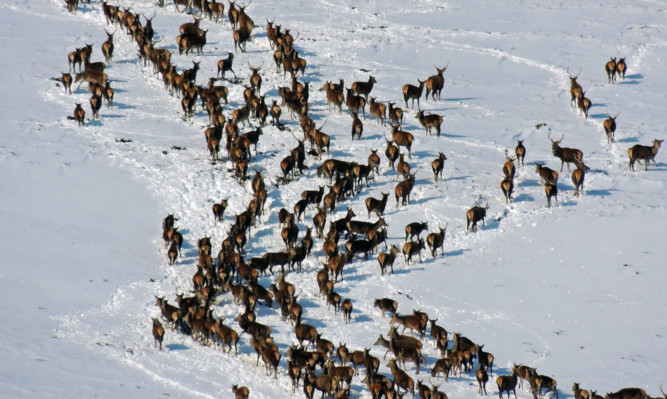Almost 700 female deer and their calves, which roam freely across the Glenisla, Glenshee and Glenprosen estates, face mass slaughter over the next week.
The cull part of a 10-year agreement instigated by the Deer Commission for Scotland, which has now merged with Scottish Natural Heritage was implemented to “protect the natural environment” by reducing deer numbers in the Angus Glens.
After a decade of gradual and selective culling, the estates have fallen short of reaching the SNH target of 19 deer per sq km. A difference of just one deer per square kilometre, said Glenisla Estate owner Major John Gibb, means the Government wants a further 690 hinds and their calves to be slaughtered before the close of the legal “culling season” on Friday.
“Given the harsh winter and the effect continued snowfall has had on recent conditions, reducing deer numbers by almost 700 simply won’t be possible without a mass cull,” said Major Gibb. “But SNH wants the estates to be solely responsible for the slaughter. They don’t want to get their hands dirty by doing it themselves.”
However, given recent adverse weather conditions and continued snowfall, Major Gibb feels it would be cruel to chase the deer through deep snow and the process would weigh heavily on the animals’ stress levels.
“I don’t feel SNH is being realistic we feel the numbers of deer have already been reduced enough,” he said.
Major Gibb said the original figure of 19 deer per sq km may as well have been “pulled out of the sky”. He said recent surveys pointed to little if any “habitat degradation” caused by the current levels of deer on the ground and, as a result, he sees no need to continue killing deer for the sake of reaching an “out of date” Government target.
“A lot of us also depend upon deer numbers for a living with continued cost pressures over the last decade, 20 deer per sq km is economically viable. But 19 is not,” said Major Gibb.
“It seems as though we are being heavily put upon by Government officialdoms for no reason. Bureaucracy is turning this into a police state.”
According to SNH, however, the agreement to reduce the number of deer across the Cairn Lochan area was signed by each of the estates involved in 2003 and they have had 10 years to kill enough deer.
An SNH spokesman said the “magic level” of 19 was agreed at the time to incorporate the objectives of sporting estates and was designed to reflect the mobility of the deer herd across the region.
Although he conceded the target was not liable to be met by the close of the legal culling season on February 15, given weather conditions, he said the estates could each apply for a two-week extension to continue the killing until the end of the month.
He said the cull of 700 deer was not inconsistent with the number of deer killed during previous years and instead said an even higher number of animals had been killed in the past for the benefit of the wider environment.
“We have certainly seen a positive change in habitats to coincide with the reduction of deer numbers,” he said. “Monitoring carried out by SNH has shown habitat degradation has not increased over the last decade.”
phstephen@thecourier.co.uk
